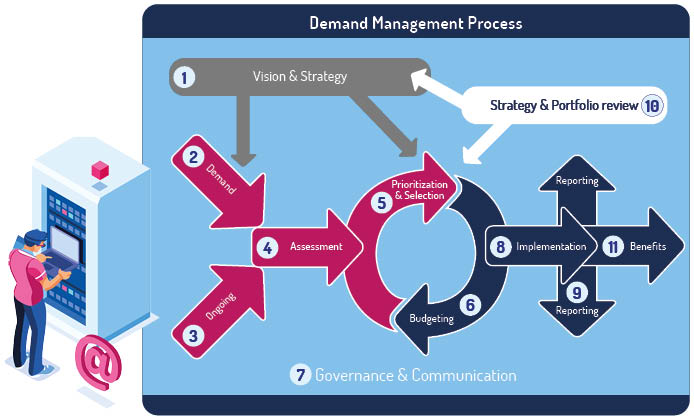In this Capture blog post, we offer IT managers, business, and project portfolio managers a concise overview of the topic of demand management and the associated process. The focus is on the following questions:
- When is a professional demand management process relevant?
- What demand management solutions does PPM software offer?
- How does your company benefit from the ITIL process method?
- Why should Demand Management be integrated with other PPM processes?
- What are the requirements for effective implementation of the IT Business Model?
The "holy grail" of resource optimization
In principle, demand management optimizes the supply and demand of internal IT services in companies. In the meantime, however, the ITIL process method is also being applied in other areas of the company, namely where resource allocations are decisive for the success of the business. Modern project management offices are no longer maximally efficient without a stringent demand management process!
Demand management process: part of holistic project portfolio management

This is because demand management contributes to a holistic project portfolio management process through interaction with other software functionalities. Leading PPM providers enable a simple entry into resource optimization, which can be gradually expanded and individually adapted.
In project portfolio management, the demand management process corresponds to the following activity sequence, whereby the boundaries to complementary PPM functionalities are fluid depending on the software provider:
- New project ideas and requirements are collected
- The idea and ticket pool is evaluated in terms of content, quantity, and, above all, collaboratively
- Depending on the data situation, the project and service evaluation can be carried out in comparison with other projects, existing resources, internal costs, the corporate strategy, and clearly defined targets.
In the implementation phase, the selected project measures can continue to be tracked with project management functions. Reporting tools allow stakeholders to be informed and governance guidelines to be automatically adhered to. Through regular results analysis, a continuously improved resource optimization and organizational learning curve is achieved.
7 Advantages of professional demand management
Companies benefit from a professional demand management process within just a few months thanks to seven key advantages:
- cross-departmental transparency from the idea stage onwards
- multidimensional, data-based project selection
- a secure business-IT alignment
- a realistic assessment of resource expenditure and value contributions of projects
- reduced opportunity costs through objective decisions
- relevant findings for the optimization of further process steps in the sense of a holistic project portfolio management
- greater innovative strength through structured idea management
Practical example: IT Business Management (ITBM)
In practice, the demand management process is often adapted for different use cases. In the provision of internal, operational IT services, incoming service requests are matched in their urgency and relevance with available resources. Incorporating internal transfer pricing increases requesters' awareness of the value of the requested service and provides IT with a solid basis for argumentation in the event of resource bottlenecks. By quantifying and intelligently tracking service tickets, recurring problems can be identified more quickly and the entire IT workflow organization can be optimized in terms of corporate strategy, performance and customer focus.
Strategic and operational excellence through professional demand management
A professional demand management process promotes strategy implementation, operational performance and has a strong impact on other processes and entire business units. The leverage effect for business success is therefore enormous!
For holistic project portfolio management, it is not necessary to introduce demand management at the beginning of a transformation phase. However, an early methodical docking to the "source" of project management has always proven successful in practice.
The cornerstones of successful process implementation
- Clear responsibilities
A demand manager or process owner is needed to ensure that a process expansion and introduction does not become bogged down in established workflows. This person is responsible for the idea pipeline or requirements management from the evaluation to the decision-making phase.
- Focused communication
Process digitization maps complex issues transparently, but in no way replaces personal stakeholder communication. The first step is to develop a common understanding of the process. A central communication task is to free demand management from the image of an additional documentation task and to make the undeniable advantages tangible as quickly as possible.
- Long-term commitment
Once the demand management process has been established, reliable process implementation must be guaranteed.
Customer success story: Erste Bank Hungary
Are you curious but want to understand the demand management process in a more practical way? Read the success story of our client Erste Bank Hungary. Despite a very well-established IT delivery process, the international financial services provider had the need to introduce a "single point of truth". The result: with the help of demand management, coordination efforts between IT and business units were reduced and the IT department's service delivery increased by 20% two years in a row.